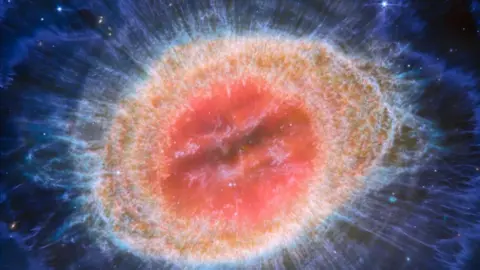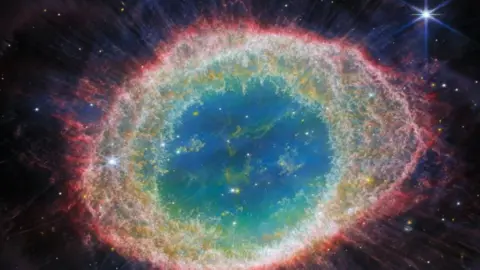Astronomy: Dying star analysed by Cardiff scientists
 JWST/NASA
JWST/NASA New images of a dying star have revealed structures that no previous telescope could detect, according to astronomers.
The pictures are of a dying star at the centre of the Ring Nebula, 2,600 light years from earth.
An international team of scientists, led by Cardiff University researchers, say they reveal a triple-star system.
The pictures show about 20,000 dust clouds, known as globules, in the nebula.
Dr Roger Wesson, a research associate at Cardiff University who led the analysis, said: "We can now see the subtle influence of a third, previously unknown star in the system, alongside a much more distant companion which was identified in 2021."
The images were captured by the James Webb Space Telescope (JWST) between July and August last year, by a team of astronomers led by Professor Mike Barlow of University College London.
Planetary nebulae such as the Ring form when stars with up to about eight times the mass of our sun exhaust the hydrogen in their cores and eject their outer layers.
As the source of much of the carbon and nitrogen in the universe, the way in which these stars evolve and die is crucial to understanding the origin of these elements, without which life on earth could not have developed.
 JWST/NASA
JWST/NASA Dr Wesson added: "Planetary nebulae were once thought of as very simple objects, roughly spherical and with a single star at their centre.
"Hubble showed that they were much more complicated than that, and with these latest images JWST is revealing yet more intricate detail in these objects."
Launched in December 2021, JWST is an international programme led by NASA with its partners, the European Space Agency and the Canadian Space Agency.
It will enable astronomers worldwide to study every phase in the history of our universe.
Dr Mikako Matsuura added: "JWST's six-metre diameter telescope is three times larger than Hubble's and also operates two infrared cameras, which can detect longer wavelengths than are visible to the human eye or indeed Hubble.
"These telescope and infrared detection innovations mean many of the Ring's details revealed in these latest JWST images were not previously visible to astronomers."

- ONE MAN AND HIS ISLAND: What's life like for Flat Holm Island’s newest warden?
- YR WYDDFA: Life on Britain's busiest mountain

